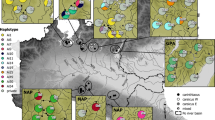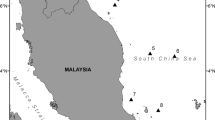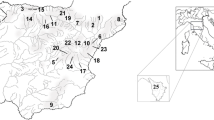Abstract
The genetic variability among Italian populations of the white-clawed crayfish (Austropotamobius pallipes) was examined to determine their phylogeography and to assess their conservation status as a management unit. A fragment of the mitochondrial DNA COI gene of 107 specimens from ten populations was sequenced, and the phylogenetic relationships were established. Two out of three haplotypes sampled in two French populations from the Rhône basin were shared with Italian populations. Despite a moderate level of genetic variability within the Italian populations of A. pallipes, no genetic structure was revealed. It has been suggested that there have been translocation events throughout the Alpine barrier between the North-Western Italian basins and the Rhône basin. Genetic exchangeability of the French and Italian populations was demonstrated in this study, and a shift of conservation efforts towards the native, congeneric Austropotamobius italicus is recommended.




Similar content being viewed by others
References
Albrecht H (1983) Besiedlungsgeschichte und ursprünglich holozane verbreitung der europäischen Flusskrebse. Spixiana 6:61–77
Avise JC (2000) Phylogeography. Harvard University Press, Cambridge
Baillie J, Groombridge B (1996) IUCN red list of threatened animals. IUCN, Gland, p 286
Bănărescu P (1992) Zoogeography of fresh waters. Vol 2. Distribution and dispersal of freshwater animals in North America and Eurasia. Aula Verlag, Wiesbaden
Beaumont MA, Panchal M (2008) On the validity of nested clade phylogeographical analysis. Mol Ecol 17:2563–2565
Bernardo JM, Ilhéu M, Costa AM (1997) Distribution, population structure and conservation of Austropotamobius pallipes in Portugal. Bull Fr Pêche Piscic 347:617–624
Bianco PG (1990) Potential role of the paleohistory of the Mediterranean and Paratethys basins on the early dispersal of Euro-Mediterranean freshwater fishes. Ichthyol Explor Freshwaters 1:167–184
Bott R (1950) Die Flusskrebse europas (Decapoda; Astacidae). Proc Senck Nat Soc 483:1–36
Brodsky SY (1983) On the systematic of palearctic crayfishes (Crustacea, Decapoda). Freshw Crayfish 5:464–470
Clement M, Posada D, Crandall KA (2000) TCS: a computer program to estimate gene genealogies. Mol Ecol 9:1657–1660
Crandall KA, Bininda-Emonds ORP, Mace G et al (2000) Considering evolutionary processes in conservation biology. Trends Ecol Evol 15(7):290–295
Demers A, Souty-Grosset C, Trouilhé M-C et al (2006) Tolerance of three European native species of crayfish to hypoxia. Hydrobiologia 560:425–432
Dieguez-Uribeondo J, Rueda A, Castien E et al (1997) A plan of restoration in Navarra for the native freshwater crayfish species of Spain Austropotamobius pallipes. Bull Fr Pêche Piscic 347:625–637
Dudgeon D, Arthington AH, Gessner MO et al (2006) Freshwater biodiversity: importance, threats, status and conservation challenges. Biol Rev 81:163–182
Dupanloup I, Schneider S, Excoffier L (2002) A simulated annealing approach to define the genetic structure of populations. Mol Ecol 11:2571–2581
Durand JD, Persat H, Bouvet Y (1999) Phylogeography and postglacial dispersion of the chub Leuciscus cephalus in Europe. Mol Ecol 8:989–997
Durand JD, Unlu E, Doadrio I et al (2000) Origin, radiation, dispersion and allopatric hybridization in the chub Leuciscus cephalus. Proc R Soc Lon B 267:1687–1697
Erwin TL (1991) An evolutionary basis for conservation strategies. Science 253:750–752
Excoffier L, Smouse E, Quattro JM (1992) Analyses of molecular variance inferred from metric distance among DNA haplotypes: application to human mitochondrial DNA restriction data. Genetics 131:479–491
Felsenstein J (1985) Confidence limits on phylogenies: an approach using the bootstrap. Evolution 39:783–791
Folmer OM, Black M, Hoeh R et al (1994) DNA primers for amplification of mitochondrial cytocrome c oxidase subunit I from diverse metazoan invertebrates. Mol Mar Biol Biotech 5:304–313
Fratini S, Zaccara S, Barbaresi S et al (2005) Phylogeography of the threatened crayfish (Genus Austropotamobius) in Italy: implications for its taxonomy and conservation. Heredity 94:108–118
Füreder L, Machino Y (1995) Record of the white-clawed crayfish Austropotamobius pallipes (Lereboullet, 1858) from Plansee (Tyrol, Austria). Ber Natwiss-Med Ver Innsbr 82:241–246
Füreder L, Reynolds JD (2003) Is Austropotamobius pallipes a good bioindicator? Bull Français Pêche Piscic 370:157–163
Gaubert P, Godoy J, del Cerro I, Palomares F (2009) Early phases of a successful invasion: mitochondrial phylogeography of the common genet (Genetta genetta) within the Mediterranean basin. Biol Invasions 11:523–546
Gopurenko D, Hughes JM, Keenan CP (1999) Mitochondrial DNA evidence for rapid colonisation of the Indo-West Pacific by the mud crab Scylla serrata. Mar Biol 134:227–233
Gouin N, Grandjean F, Bouchon D et al (2001) Population genetic structure of the endangered freshwater crayfish Austropotamobius pallipes assessed using RAPD markers. Heredity 87:80–87
Gouin N, Grandjean F, Souty-Grosset C (2006) Population genetic structure of the endangered crayfish Austropotamobius pallipes in France based on microsatellite variation: biogeographical inferences and conservation implications. Fresh Biol 51:1369–1387
Grandjean F, Souty-Grosset C (2000) Mitochondrial DNA variation and population genetic structure of the white-clawed crayfish, Austropotamobius pallipes pallipes. Conserv Genet 1:309–319
Grandjean F, Souty-Grosset C, Raimond R et al (1997) Geographical variation of mitochondrial DNA between populations of the white-clawed crayfish Austropotamobius pallipes. Fresh Biol 37:493–501
Grandjean F, Gouin N, Frelon M et al (1998) Genetic and morphological systematic studies on the crayfish Austropotambius pallipes. J Crust Biol 18:549–555
Grandjean F, Harris DJ, Souty-Grosset C et al (2000) Systematics of the European endangered crayfish species Austropotamobius pallipes (Decapoda: Astacidae). J Crust Biol 20:522–529
Grandjean F, Frelon-Raimond M, Souty-Grosset C (2002) Compilation of molecular data for the phylogeny of the genus Austropotamobius: one species or several? Bull Fr Pêche Piscic 367:671–680
Hasegawa M, Kishino H, Yano T (1985) Dating the human-ape splitting by a molecular clock of mitochondrial DNA. J Mol Evol 22:160–174
Holdich DM, Rogers WD (1996) Government action to keep signals on the right lines. Fish Farmer 19:20–21
Huelsenbeck JP, Ronquist F (2001) MrBayes: Bayesian inference of phylogenetic trees. Bioinformatics 17:745–755
Huelsenbeck JP, Ronquist F, Nielsen R et al (2001) Bayesian inference of phylogeny and its impact on evolutionary biology. Science 294:2310–2314
Karaman M (1963) Studie der Astacidae. Hydrobiologia 22:111–132
Largiader CR, Herger M, Lörtscher M et al (2000) Assessment of natural and artificial propagation of the white-clawed crayfish (Austropotamobius pallipes species complex) in the Alpine region with nuclear and mitochondrial markers. Mol Ecol 9:25–37
Laurent PJ, Nicolas J, Paris L (1993) Five years of action in Lorraine and Morvan (France) to restore the noble crayfish, Astacus astacus. Freshw Crayfish 9:380–389
Machino Y, Füreder L, Laurent PJ et al (2004) Introduction of the white-clawed crayfish Austropotamobius pallipes in Europe. Ber nat-med Verein Innsbruck 91:187–212
Moritz C (1994) Defining ‘Evolutionary Significant Units’ for conservation. Trends Ecol Evol 9:373–375
Nascetti G, Andreani P, Santucci F, Iaconelli M, Bullini L (1997) Struttura genetica di popolazioni italiane di gambero di fiume (Austropotamobius pallipes) e strategie per la sua conservazione. S It E Atti 18:205–208
Neveu A (2007) Annual variability in reproduction of the white-clawed crayfish (Austropotamobius pallipes): implications for survival. Acta Oecol 32:67–76
Palmer M (1994) Action plan for the conservation of the native freshwater crayfish Austropotamobius pallipes in the United Kingdom. JNCC Rep. No. 193 Peterborough (UK)
Panchal M, Beaumont MA (2007) The automation and evaluation of nested clade phylogeographic analysis. Evolution 61:1466–1480
Paulo S, Jordan WC, Bruford MW, Nichols RA (2002) Using nested clade analysis to assess the history of colonization and the persistence of populations of an Iberian lizard. Mol Ecol 11:809–819
Perdices A, Doadrio I (2001) The molecular systematics and biogeography of the European cobitids based on mitochondrial sequences. Mol Phylogenet Evol 19:468–478
Perdices A, Doadrio I, Economidis PS, Bohle J, Banarescu P (2003) Pleistocene effects on the European freshwater fish fauna: double origin of the cobitid genus Sabanejewia in the Danube basin (Osteichyes: Cobitidae). Mol Phyl Evol 26:289–299
Posada D, Crandall KA (1998) Modeltest: testing the model of DNA substitution. Bioinformatics 14:817–818
Posada D, Crandall KA, Templeton R (2000) GeoDis: a program for the cladistic nested analysis of the geographical distribution of genetic haplotypes. Mol Ecol 9:487–488
Rogers WD, Holdich DM (1995) Conservation and management of crayfish in Britain. Freshw Crayfish 10:583–595
Rozas J, Rozas R (2001) DnaSP 3.52 DNA sequence polimorphism, software for nucleotidic polymorphism analysis. Universitat de Barcelona
Salvidio S, Cresta P, Doria G (1993) Preliminary survey on the distribution of the freshwater crayfish Austropotamobius pallipes in Liguria, N.W. Italy. Crustaceana 65(2):218–221
Salzburger W, Brandstätter A, Gilles A et al (2003) Phylogeography of the vairone (Leuciscus souffia, Risso 1826) in Central Europe. Mol Ecol 12:2371–2386
Santucci F, Iaconelli M, Andreani P (1997) Allozyme diversity of European freshwater crayfish of the genus Austropotambius. Bull Fr Pêche Piscic 347:663–676
Scalici M, Belluscio A, Gibertini G (2008) Understanding population structure and dynamics in threatened crayfish. J Zool 275:160–171
Schneider S, Excoffier L (1999) Estimation of demographic parameters from the distribution of pairwise differences when the mutation rates vary among sites: application to human mitochondrial DNA. Genetics 152:1079–1089
Schneider S, Roessli D, Excoffier L (2000) ARLEQUIN, ver 3.0: software for population genetics data analysis. http://anthro.unige.ch/arlequin
Simberloff DS (1972) Properties of the rarefaction diversity measurement. Am Nat 106:414–418
Šlechtovà V, Bohlen J, Freyhof J et al (2004) The Alps as barrier to dispersal in cold-adapted history and taxonomic status of the bullhead in the Adriatic freshwater drainage. Mol Phylog Evol 33:225–239
Starobogatov YI (1995) Taxonomy and geographical distribution of crayfishes of Asia and East Europe (Crustacea, Decapoda, Astacoidea). Arthropoda Selecta 4(3/4):3–25
Stefani F, Galli P, Zaccara S et al (2004) Genetic variability and phylogeography of the cyprinid Telestes muticellus within the Italian peninsula as revealed by mitochondrial DNA. J Zool Syst Evol Res 4:323–331
Susnik S, Snoj A, Dovc P (2001) Evolutionary distinctness of grayling (Thymallus thymallus) inhabiting the Adriatic river system, as based on mtDNA variation. Biol J Linnean Soc 74:375–385
Swofford DL (2001) PAUP* Version 4.0b10—phylogenetic analysis using parsimony [Computer software and manual]. Sinauer Assoc, Sunderland
Taugbøl T, Skurdal J, Hasteint T (1993) Crayfish plague and management strategies in Norway. Biol Conserv 63:75–82
Templeton AR (1998) Nested clade analysis of phylogeographic data: testing hypothesis about gene flow and population history. Mol Ecol 7:381–397
Templeton AR (2008) Nested clade analysis: an extensively validated method for strong phylogeographic inference. Mol Ecol 17:1877–1880
Templeton AR (2009) Why does a method that fails continue to be used? The answer. Evolution 63:807–812
Templeton AR, Sing CF (1993) A cladistic analysis of phenotypic associations with haplotypes inferred from restriction endonuclease mapping. IV. Nested analysis with cladogram uncertainty and recombination. Genetics 134:659–669
Templeton AR, Boerwinkle E, Sing CF (1987) A cladistic analysis of phenotypic associations with haplotypes inferred from restriction endonuclease mapping and DNA sequence data. I. Basic theory and analysis of alcohol dehydrogenase activity in drosophila. Genetics 117:343–351
Templeton AR, Crandall KA, Sing CF (1992) A cladistic analysis of phenotypic associations with haplotypes inferred from restriction endonuclease mapping and DNA sequence data. III. Cladogram estimation. Genetics 132:619–633
Thompson JD, Gibson TJ, Plewniak F et al (1997) The Clustal X windows interface: flexible strategies for multiple sequence alignment aided by quality analysis tools. Nucleic Acids Res 24:4876–4882
Trontelj P, Machino Y, Sket B (2005) Phylogenetic and phylogeographic relationships in the crayfish genus Austropotamobius inferred from mitochondrial COI gene sequences. Mol Phylog Evol 34:212–226
Trouilhe M-C, Souty-Grosset C, Grandjean F et al (2007) Physical and chemical water requirements of the white-clawed crayfish (Austropotamobius pallipes) in western France. Mar Freshw Ecosyst 17:520–538
Tsigenopoulos CS, Kotlík P, Berrebi P (2002) Biogeography and pattern of gene flow among Barbus species (Teleostei: Cyprinidae) inhabiting the Italian Peninsula and neighbouring Adriatic drainages as revealed by allozyme and mitochondrial sequence data. Biol J Linn Soc 75:83–99
Weiss S, Persat H, Eppe R, Schloetterer C, Uibleins F (2002) Complex patterns of colonization and refugial revealed for European grayling Thymallus thymallus, based on compete sequencing of the mitochondrial DNA control region. Mol Ecol 11:1393–1407
Zaccara S, Stefani F, Galli P et al (2004) Taxonomic implications in conservation management of white-clawed crayfish (Austropotamobius pallipes) (Decapoda, Astacidae) in Northern Italy. Biol Conserv 120:1–10
Zaccara S, Stefani F, Crosa G (2005) Diversity of mitochondrial DNA of the endangered white-clawed crayfish (Austropotamobius italicus) in the Po River catchment. Freshw Biol 50:262–1272
Zaccara S, Stefani F, Delmastro GB (2007) Phylogeographical structure of vairone Telestes muticellus (Teleostei, Cyprinidae) within three European peri-Mediterranean districts. Zool Scr 36(5):443–453
Acknowledgments
Many thanks are due to Catherine Souty-Grosset (Genetique et Biologie des Populations de Crustaces, Université de Poitiers, France) for providing samples from the French basins, to Paolo Galli (Department of Biotechnology and Biosciences, University of Milano-Bicocca, Italy), for his help in the laboratory and for fruitful advice. This study was funded, in part, by the University of Milano-Bicocca and by the University of Insubria. Finally, the authors wish to thanks an anonymous referee for helpful comments.
Author information
Authors and Affiliations
Corresponding author
Rights and permissions
About this article
Cite this article
Stefani, F., Zaccara, S., Delmastro, G.B. et al. The endangered white-clawed crayfish Austropotamobius pallipes (Decapoda, Astacidae) east and west of the Maritime Alps: a result of human translocation?. Conserv Genet 12, 51–60 (2011). https://doi.org/10.1007/s10592-009-9986-x
Received:
Accepted:
Published:
Issue Date:
DOI: https://doi.org/10.1007/s10592-009-9986-x




